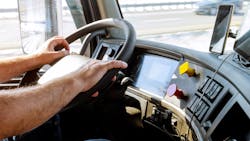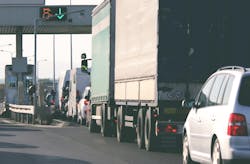How optimizing routes can impact truck driver satisfaction
Editor's note: This is part two of a series on how fleets are optimizing routes and dispatch operations to provide better visibility to drivers, while also managing the complexities of toll costs. Read part one here.
A heavy focus—and even best practice—for carriers today is making sure that all the mapping and routing data available within their organization is available to their drivers. That's according to Doug Schrier, SVP of strategy at Transflo, which provides technology to manage loads, routes, and documentation within a mobile app.
When dispatching a driver to a load, for instance, the driver should have detailed insights into the facility’s hours of operations, information about on-site restroom availability, specific safety requirements, and full trailer visibility.
“That seems simple when you think about it, but in reality, there are so many drivers out there today who don’t have the same visibility as the fleet in regard to where the trailer is that they have been assigned to pick up,” Schrier said. “Frequently, there is a disconnect between those, and that is something that we recommend giving visibility to the driver.”
As a driver approaches and pulls into a yard, they can go into trailer view on Transflo’s app and see exactly where their trailer is and drive directly there. Schrier noted that this feature can help reduce additional miles, as well as mitigate the distraction and time wasted of looking for an empty trailer. It also helps eliminate driver frustration.
See also: Fleets explore all that telematics can do
Fleets can also utilize data from their telematics and navigation devices to control unaccountable or unpaid miles. According to Schrier, a best practice is for fleet managers to analyze the benefits compared to the disadvantages of running additional miles—whether it’s to get a driver home for a break or appointment, or a driver burning extra time between refrigerated loads to get to a washout facility that is out of the way from the optimized route.
“The first thing I would tell any customer is know your unaccountable, out-of-route miles,” Schrier advised. “Know the difference between the toll miles that your truck ran and the toll miles that you got paid to execute, and try to find the gaps of what it costs to have these large amounts of unaccountable or unpaid miles.”Rishi Mehra, director of operations and strategy for Trimble MAPS, also pointed out that fleets could look at post-trip analysis data to see if a driver deviated from an assigned routing plan. That, he said, is key to determining how much extra time, as well as costs, were added to the trip.
The other piece, Mehra added, is reviewing the data to calculate the total amount of time a driver spent at a customer facility. Detention time can be calculated from the GPS data and used to charge customers accordingly.
Driver capacity, asset utilization
Making the most of the data from navigation and telematics devices can also help fleets boost driver capacity and utilize their assets more efficiently. And as the industry transitions to 5G, fleets will have even more detailed insights into the location and status of their tractors and trailers, Marygrace Pinizzotto, a segment adviser for transportation at T-Mobile, pointed out.
T-Mobile has partnered with telematics providers Geotab and Spireon to provide fleets with near-real-time visibility into asset tracking, dispatch and route optimization, and toll management.
Optimizing capacity and assets mean that, when possible, vehicles are routed to the closest and most appropriate job, added David Cassie, a segment adviser for transportation at T-Mobile. He also pointed out that leveraging dispatch and routing technology could help midsize trucking companies scale and grow their businesses.
“If they take on more jobs, maybe they don’t need more vehicles but the right vehicles in the right spots based on where the jobs are, based on traffic patterns, and based on office locations,” Cassie advised.
“Some of it comes down to routing, but some of it comes down to utilization and having the drivers understand that there are benefits to driving fewer miles in a day,” Cassie added. “What we’ve seen in fleets that have deployed telematics and routing is a significant reduction—sometimes up to 20% in miles driven. Not because they were being forced to drive a certain direction, but because they knew there was technology on the vehicle that provided that information, and it was a natural inclination to fuel up or stop in a more route-friendly location.”
Proper route planning, utilization, and driving fewer miles in a day can help reduce maintenance costs and vehicle downtime, Cassie added.
Taking it a step further, Pinizzotto pointed out that setting succinct and clear key performance indicators can help fleet managers tackle their operational goals.
“It goes back to what the organizational goals are, and you want to start small,” Cassie added. “If fuel efficiency is your organization’s No. 1 focus area, I would say look at idle time metrics and miles driven per day. That goes into utilization.”
Fleets’ operational efficiencies also trickle down to other business endpoints. From a supply chain perspective, shippers and other players seek transparency more than ever. For instance, a warehouse expecting a shipment would like to know within a certain window when that freight is going to show up so dock workers can prepare to unload and make room.
“A lot of customers have just-in-time delivery,” Pinizzotto added. “They have contracts with transportation companies saying that deliveries need to be in by a certain time because the production line will stop, for instance. A lot of big manufacturing companies have those limits, so having visibility into what’s coming at them is key.”
Driver satisfaction
Visibility and incorporating KPIs can also translate into driver and employee satisfaction. T-Mobile’s Cassie pointed out that drivers want to know that companies are investing in technology that’s ultimately going to help them. He added that the younger generation of workers and drivers coming into the workforce are going to expect to use technology.
Aside from implementing a navigation platform that is meant for trucking operations, Transflo’s Schrier suggested fleets incorporate fuel and parking plans to make drivers’ lives easier on the road.
“Those are two big items that the driver has to deal with on a daily basis. They have to put diesel in the vehicle, and they are going to have to take a break within the first eight hours of service and within their 10-hour shift,” Schrier said. “How do you build that in for your drivers and make it so it’s more intuitive? If you can give drivers more insights—five or 10 minutes [even]—it benefits the fleet because those are additional minutes you have to run additional freight.”
Trimble’s Mehra also reiterated the importance of including tools for parking in a truck driver’s technology arsenal.
“A lot of fleets today leave it up to the driver to plan their day and manage their HOS regulations,” Mehra said. “What they can do better from a route planning perspective is give the driver the tools that show the driver how they can maximize their travel time and still find a safe place to take their mandated rest breaks.”
Running repeatable routes can also help when it comes to enhancing driver safety and even satisfaction, Mehra said. He added that the navigation experience and cross-communication between the back office and inside the cab are critical to helping drivers reduce menial tasks that can frustrate them or distract them from the task at hand.
That’s where standardized routing can help, specifically when it comes to providing last-mile directions for entering and exiting facilities.
“If the driver misses the entrance to the facility, the detour and having to drive those extra miles and come back has been a key source of accidents or damage to property in cases where the driver feels lost,” Mehra said. “Every location of a shipper, every terminal, every rest area has a geofence. Taking the GPS directions of a driver’s vehicle, you can automatically trigger some of these arrival and departure events and not require the driver to manually do things. Once you automate some of these pieces, the driver just has to focus on the load itself.”
All professional drivers really want is to deliver and pick up their loads safely and on time, Andrew Johnson, chief marketing officer for PrePass Safety Alliance, pointed out. From a routing and dispatch perspective, he added that bypassing weigh stations helps drivers stay on time and can also help carriers improve efficiency.
Aside from weigh station bypass, the PrePass mobile app also provides drivers information about roadway hazards along their routes ahead of time so they are better prepared to respond.
“At the end of the day, there are many variables, including hours of service, weather, road conditions, etc., that can go wrong in a driver’s day,” Johnson said. “The goal then is to eliminate or reduce as many of those time variables as possible.”In general, whether it’s toll management, route optimization, or dispatch technologies, the more forward-thinking fleets likely will look at what’s best to improve their specific KPIs. For Robert Bernal, Southwestern Motor Transport's VP of information technology, driver and employee feedback is critical, and adoption of new technologies is a team effort.
"We’re trying to improve customer satisfaction and efficiencies with our company, so we want buy-in, but we aren’t going to force it down people’s throats," Bernal said. "We include team members to offer their input to help make something better. It’s part of that culture and knowing that it’s going to keep business and bring in more business."
About the Author

Cristina Commendatore
Cristina Commendatore is a past FleetOwner editor-in-chief. She wrote for the publication from 2015 to 2023.


